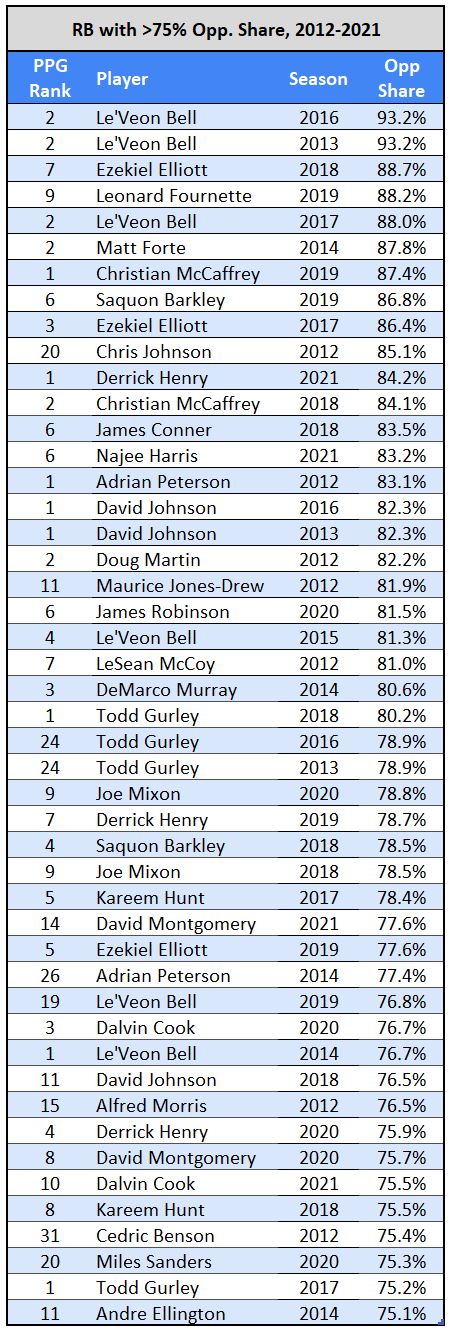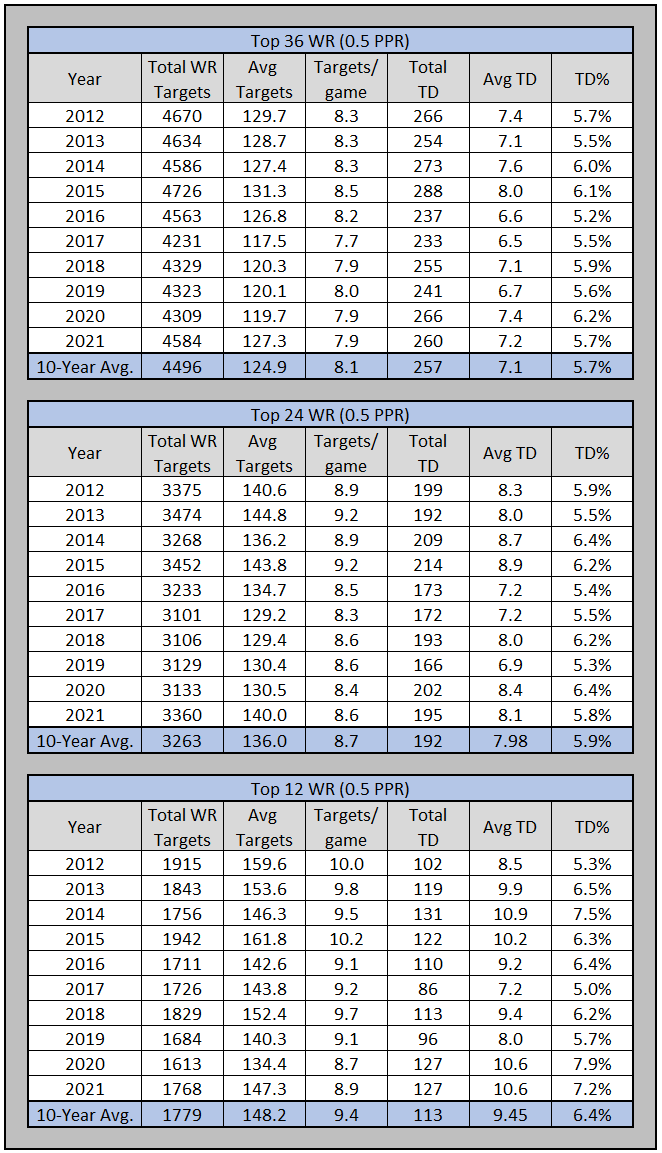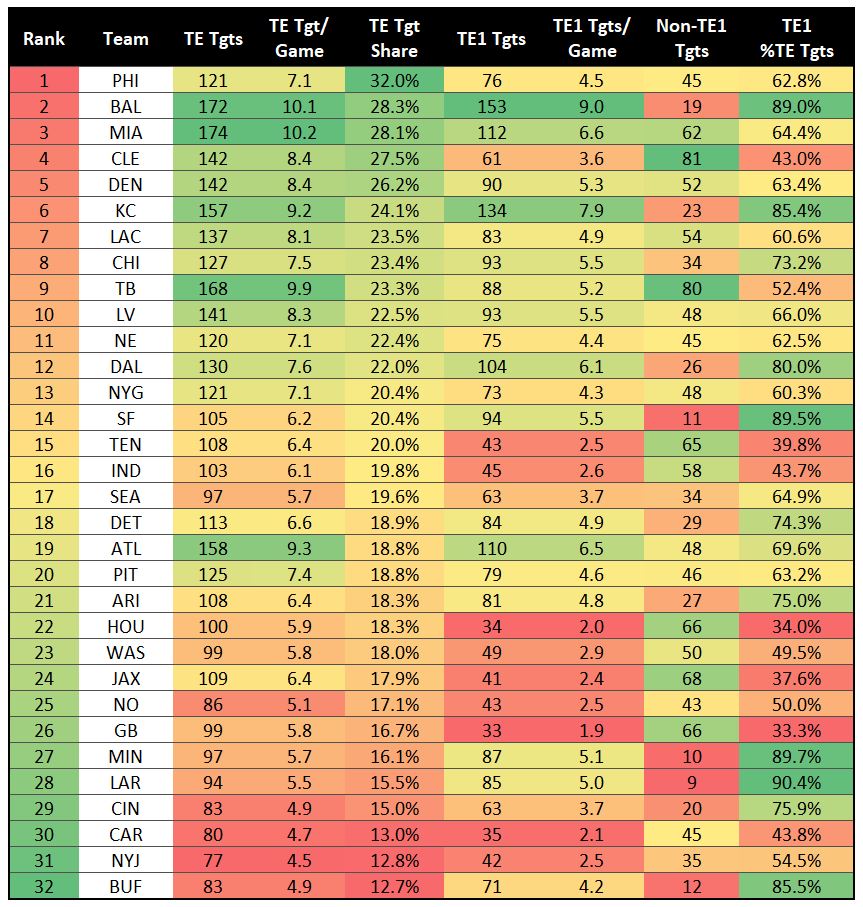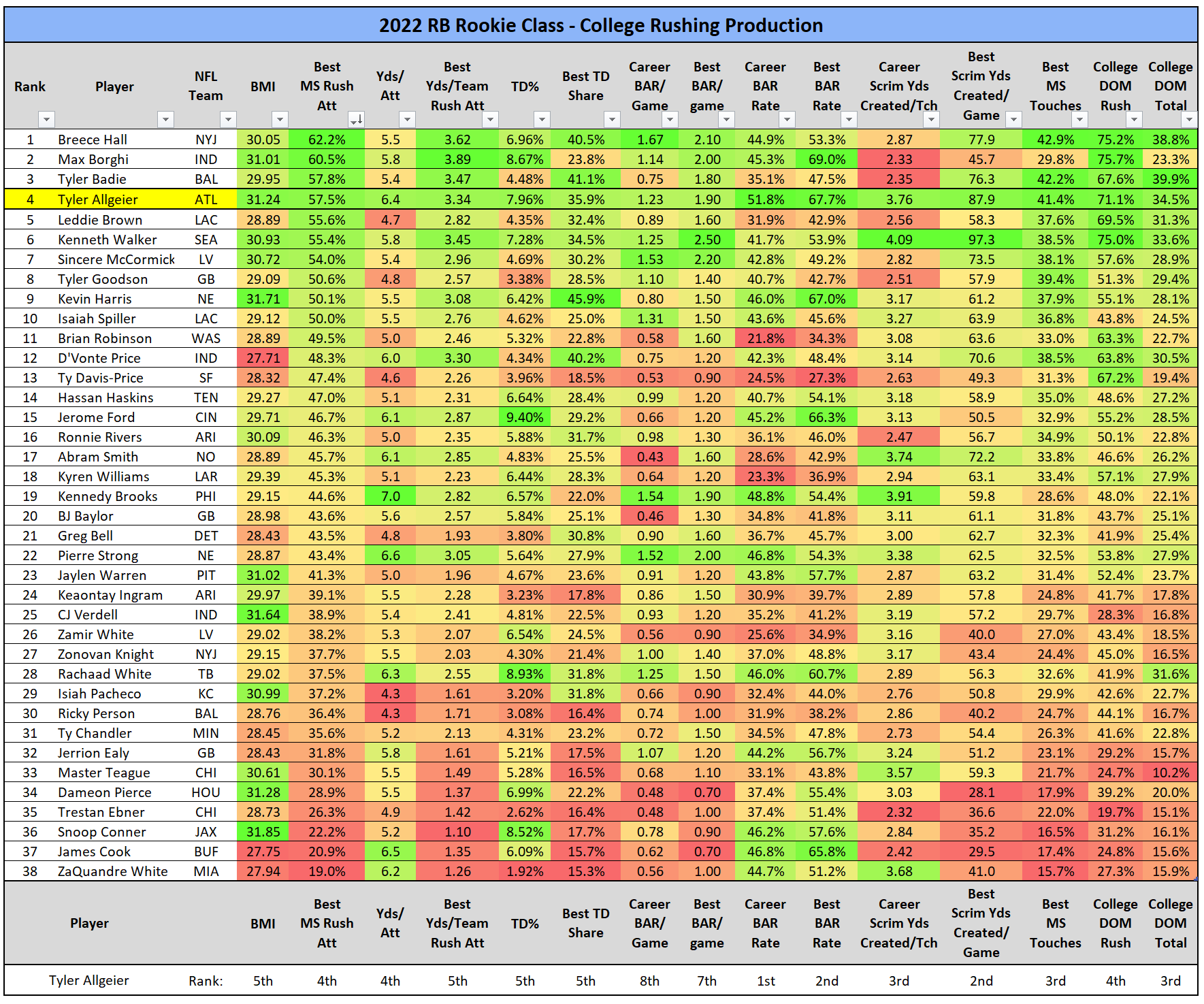5 Underrated Players Based on ADP
Every year as more and more fantasy managers play fantasy football across a multitude of platforms, we gain access to accumulating draft data. Specifically, “Average Draft Positions” (ADP) materialize across the different formats giving us a somewhat moving target of where players are being drafted on average. This can be very useful data in preparation for upcoming drafts as you can formulate strategies to acquire value. ADP is a fluctuating snapshot of large sample sizes, and there will always be value available for some players at those ADPs. This is another example of the importance of knowing your league mates. Most platforms now have ADP built into the draft board, and knowing whether your league mates are drafting based on that can be used to your advantage.
It will not always work out. For example, if you see David Montgomery with an ADP of RB20 (which is a value…foreshadowing), he may not fall to that in your draft. Like any fantasy football analysis, this is another method to try and increase your probability of gaining something positive, in this case, a draft pick at value. In other words, a draft pick who has a good chance to outperform their ADP. This should not be confused with the concept of “league winners” that frequently gets tossed around. While trying to unearth value at ADP during a draft can lead to a league winner-type player, that is not the intent of this article.
In this article, I highlight five players who are of good value if you can acquire them where they are currently being drafted on average. ADP data is courtesy of MyFantasyLeague.com. I looked at this from a season-long redraft format with the following settings:
- Points Per Reception (PPR)
- 12-Team Leagues
- 1QB, non-Tight End Premium (TEP)
5. David Montgomery (RB, Chicago Bears)
David Montgomery enters his fourth NFL season the same way he entered his third. As an unsexy, underrated RB who will likely outperform his redraft ADP. Since his rookie season in 2019, Montgomery has finished as the RB8 and RB14 in points per game (PPR) the last two seasons. Montgomery’s current ADP sits at 47th overall, and the 20th RB selected. I believe Montgomery will outperform this ADP and is a good value if you can land him at that draft price.
A big question mark for the Bears offense in 2021 is second-year QB Justin Fields. The offense, in general, is relatively lacking in offensive weapons. Adding that to Fields’ dismal rookie season, many view the Bears as the proverbial “dumpster fire” in 2022. To be clear, I will not be picking the Bears to win the NFC North division I’ll likely have them in the cellar. But, as everyone should know by now, that does not automatically mean there aren’t multiple fantasy-relevant values on the team.
We do not have much of a track record with Fields and Montgomery playing together last year. Fields earned his first start in Week 4, which is the game Montgomery suffered a knee sprain, missing the next four games. In that Week 4 game together, Monty rushed for over 100 yards but had zero targets. In the other two games the two played together (Weeks 13 and 14), Monty had 11 catches on 13 targets, which was sandwiched between two games (Week 12 and Week 15) wherein Monty saw nine targets in each. Season-long, Monty averaged 4.0 targets per game, ranking 14th among RBs. Once he returned from injury, that number jumped to 4.7 targets per game from Week 9 on, and during the four-game stretch between Week 12 and Week 15, he averaged 7.8 targets per game.
I realize I am cherry-picking sample sizes here, but the point is not that Monty is a top 5 dual-threat RB. Rather, it is to show that he has pass-catching in his skill set, and has shown he can be a productive, but not necessarily efficient, 3-down back. And he has no real competition for pass-catching out of the backfield. Khalil Herbert is a decent handcuff and played well in Montgomery’s absence last season. But Montgomery resumed his above-average workload once he returned in Week 9. Tarik Cohen is long gone, and the only other RB with pass-catching in their skill set is 6th round rookie out of Baylor, Trestan Ebner. Montgomery’s advanced statistics do not jump off of the page, except in one crucial area: Opportunity Share (% of team rush attempts plus RB targets):
- 2020: 75.7% (5th)
- 2021: 77.6% (3rd behind only Najee and Henry)
To put this in perspective, the following shows RBs who have attained a 75%+ opportunity share dating back to 2012 (47 total instances), and where they finished in fantasy points per game:
The average PPG finish is RB8, and these are the “hit rates” of 75%+ opportunity share RBs finishing in the Top 20, Top 15, and Top 10 based on this data:
- Top 20: 91.5%
- Top 15: 85.1%
- Top 10: 72.3%
Without injuries to RBs ahead of him in the NFL pecking order, I do not project Montgomery to finish as a Top 10 RB. I also do not see anything that will reduce Montgomery’s opportunity share in a significant way, and he was still able to maintain that 75%+ rate in the train wreck that was the Bears’ offense last season. I do project a strong likelihood he finishes as a Top 15 RB, and I’m taking him ahead of a few of the RBs in front of his ADP (James Conner, Cam Akers).
4. Cole Kmet (TE, Chicago Bears)
Yes, I am starting with two Chicago Bears. But it’s not that surprising. ADP values can often be found in players on teams either coming off of a poor offensive season and/or who are projected to struggle offensively in the upcoming season (both in this case). My thoughts on Kmet (and Montgomery) are predicated on me thinking Justin Fields does take the next step this season. Kmet is currently being drafted as the TE13, behind Mike Gesicki (TE12), Pat Freiermuth (TE11), and Dawson Knox (TE10). I would take him ahead of Gesicki and Freiermuth and might have him ahead of Knox when it’s all said and done.
Kmet had a quiet rookie season in 2020 and did not bust out fantasy-wise in 2021 either, finishing as the TE25 in fantasy points per game. But there were signs of a potential break-out and his situation has only improved entering his third season. For starters, Kmet earned a total of 93 targets, which is an impressive number for a second-year TE. As you can see, since 2000, only 12.5% of TEs in their first or second season have notched 90+ targets, which is an impressive list.
[revised]
Since 2000 a TE had 90+ targets 120 times. Of those 120 times, only 15 did it in their 1st or 2nd season (12.5%)
J Shockey
T Heap
A Gates
Witten
Pettigrew
J Graham
Gronk
A Hernandez
M Rivera
E Engram
Kittle
Andrews
Hockenson
PittsThis is a Cole Kmet tweet pic.twitter.com/6sRqBCxPIT
— Scott Rinear (@MunderDifflinFF) July 21, 2022
Kmet was 6th in snap share (83.7%), 12th in air yards per game (43.4) and is now a top-2 passing option in the Bears’ offense (alongside Darnell Mooney), so these numbers, along with his target share, should increase in 2022. Kmet didn’t make more fantasy noise last year because of TDs, or in his case, zero TDs. And while veteran red zone TE Jimmy Graham is no longer providing any competition, that did not have much of an impact last season. Kmet’s zero TDs should be viewed as an outlier. His five endzone targets matched George Kittle and were one more than Travis Kelce received. We can’t compare a 0% TD% to anything, but we can look at average TD% to see what an average season would have looked like for Kmet last year without the anomalous goose egg. Over the last 10 seasons, the average TD% for top 24 TEs is 6.1%. If you apply that to Kmet’s 93 targets last year, you get 5.7 TDs. With just the 10-year average TD%, Kmet would have finished as the TE17, eight spots higher. This is a hypothetical exercise but applying a 10-year sample size average TD rate certainly falls within the realm of Kmet’s range of outcomes.
An uptick in TDs and a clear path to 100+ targets, combined with what I project to be a big step forward for Justin Fields, is why I have Kmet closer to TE10, making his TE13 ADP a good value.
See this previous article I wrote for FantasyData for more data on TD
 Sign Up Today To Continue Reading…
Sign Up Today To Continue Reading…
The rest of this article is for FantasyData Subscribers only. Luckily for you, now is one of the best times of the year to subscribe. We are offering amazing deals on our Annual subscriptions. That means you get all our awesome DFS content, projections, rankings, and tools along with downloadable data for one full year. You will be set up for the rest of this NFL season and almost all of next year!
3. Jakobi Meyers (WR, New England Patriots)
Two years ago, I would have never imagined including Jakobi Meyers on this list. Playing his college ball at North Carolina State, Meyers went undrafted in 2019 and signed with the New England Patriots as an undrafted free agent. He earned only one start his rookie year and finished the season with only 41 targets and 359 receiving yards. Meyers was not on the fantasy radar. Rather than fading into unknown obscurity like so many late-round and undrafted WRs before him, Meyers took a noticeable step forward in 2020, doubling his targets (81) and receiving yards (729). The obscurity starts to dissipate when an undrafted WR hits 80 targets in year two. Meyer’s ADP heading into 2021 was WR57, which was appropriate at the time with his WR53 finish in 2020 and the Patriots handing the QB reigns over to an unproven rookie in Mac Jones. Meyers made strides in his sophomore campaign to ascend from the forgotten realm of failed WRs but still did not make much fantasy noise.
Meyers made another significant jump in 2021 to the tune of 126 targets (22nd) and a 24.4% target share (19th), finishing as the WR29. And that included only two TD receptions. Entering 2021, Meyers was still looking for his first NFL TD. And that search extended well into the season until Week 10, to a well-deserved team celebration.
Jakobi Meyers scored his first NFL TD! 🐺🐺🐺 pic.twitter.com/93DECXOEGX
— Pack Pride (@PackPride) November 14, 2021
Meyers did not have a lot of TD opportunities with only 13 red zone targets and four end zone targets on the season, but two TDs on 126 targets (1.59% TD rate) is well below what would be expected on average. If you just look at the Top 36 WRs over the last ten years, the average TD rate is 5.7%.
Using the same hypothetical scenario as with Kmet, if you apply that rate to Meyers’ 126 targets you get 7.2 TDs. Meyers finished the fantasy season as the WR29, within the Top 36 but at the lower end, so I’m not saying Meyers specifically should score 7+ TDs with 126 targets. The average TD rate is simply used as a frame of reference to speculate on potential positive TD regression. Additional context (Meyers’ low usage in the red zone) cannot be ignored. But I would still expect Meyers to score more than two TDs if he matches or exceeds that target volume in 2022.
What doesn’t make sense and where the value comes in is Meyers’ current ADP, which somehow sits at WR56 off the board. Meyers has taken big steps forward each year of his career, and he outperformed his 2021 ADP by 28 spots (WR57 ADP to WR29 finish), with a lower TD rate than expected, even with his non-red zone role. Meyers will remain Mac Jones’ favorite target in 2022. The addition of DeVante Parker will have a slight impact but Meyers ran 66.7% of his routes from the slot last season and had a career-high snap rate of 84%, so he’ll be on the field a lot, mostly in the slot, while Parker will be on the outside. WR57 is a ridiculous value for a WR who will likely finish within the Top 36.
2. Gerald Everett (TE, Los Angeles Chargers)
One subject many analysts pursue between seasons is searching for potential diamonds in the rough that is later round TEs. If I miss out on the top-tier TEs and find myself punting on the position in a draft to redirect that value elsewhere, I want to have a few late-round upside targets to gamble on. Let’s say I wait a bit on TE and select Cole Kmet as my TE1. Depending on roster size, I would also want a cheap, low-risk/potentially high-reward TE on my bench.
One TE I’m looking at in 2022 is Gerald Everett. A free agent signing by the Chargers, Everett is in an ideal situation for a TE who flashed during his first season as a team’s top TE in Seattle. Everett has shown improvement in each of his NFL seasons, including career highs in snap% (75%), targets (63), receptions (48), catch% (76.1%), target share (15.2%), and fantasy PPG finish (TE20). Now, some of those numbers are not impressive without context. The point is he showed this improvement with the Seahawks, one of the least ideal offenses for TEs for years.
The following table shows each team’s TE involvement in 2021, including TE targets, TE target share and the percentage of TE targets that went to the team’s TE1.
You can see Seattle ranked 17th in TE target share. The league average in 2021 was 20.4%. The Seahawks have consistently been sub-20%. Yes, targets are earned by individual players, but team offensive schemes can greatly influence target opportunities across position groups. What you can also see in this data is that the Chargers were a much more TE-friendly offense in 2021. Chargers TEs have averaged a 23.0% target share since Justin Herbert became the starter, including a 7th-bestth best 23.5% last season. More generally, the Chargers simply ran more plays than the Seahawks. The Seahawks were borderline historically bad in plays per game and time of possession in 2021. To put this in perspective, Everett’s 15.2% target share netted 63 targets with the Seahawks. Jared Cook, the Chargers 2021 TE1, had a 13.5% target share, resulting in 83 targets.
One reason this is a sleeper call, and that Everett’s ADP picks up right where he left off at TE19 is that Cook commanded a below-average percentage (60.6%) of the total TE targets (ranked 20th, see TE table above). For context, Everett comprised 64.9% of the Seahawks total TE targets (ranked 14th). On the surface this implies that while Herbert does target TEs at a relatively high rate, he spreads it around among his TEs, therefore capping each player’s fantasy value (Cook finished as TE21). This is where the projecting comes in, where Everett’s TE19 price tag becomes low risk with a potentially high reward. I don’t think this “spread it around” amongst the TEs is an offensive theme for the Chargers. It was due to Cook being 35 and not very good anymore. In 2020 with Justin Herbert, the Chargers TE1 (Hunter Henry) secured 71.5% of the total TE targets, which would have ranked 12th in 2021, and finished as the TE12.
So, which is it? I believe Everett will be closer to the Henry side than the Cook side with Herbert as his QB in the Chargers system. The other Chargers TEs are Donald Parham, who has averaged 23.5 targets in his first two seasons, Stephen Anderson, who hasn’t eclipsed 20 targets since he was a Texan in 2017 and second-year player Tre’ McKitty, who might have a cool name but earned only eight targets last year.
And while Everett is 28 and entering his 6th season, he still showed his athleticism at times last year. An athleticism that has always been there as shown by his 88th percentile 40-time, 94th percentile burst score and 91st percentile college dominator rating. He outplayed Cook in 2021 on much less opportunity. Each had 48 receptions on 20 more targets for Cook. Cook’s 57.8% catch rate was abysmal for a TE while Everett’s 76.1% was near the top. Cook did lead the NFL in routes run per snap (73.2%) while Everett ran a route on only 56.1% of his snaps. If Everett, who is younger, more efficient and more athletic, is unleashed in a similar manner with the Chargers, he could easily outperform his TE19 ADP.
1. Tyler Allgeier (Atlanta Falcons)
This one is more of an end-of-your-bench dart throw. I have spent a lot of time on the 2022 rookie class this offseason, and it is important to provide relevant context even with takes of the dart throw variety. Tyler Allgeier may seem like an odd choice here. He is currently listed as the third RB on the Falcons depth chart behind Cordarrelle Patterson and Damien Williams and lasted until the 5th round of the 2022 NFL Draft. An ADP of RB48 seems about right based on these factors. But I think Allgeier fits the mold of a rookie lottery ticket stash in redraft formats. I believe he’ll enter the season ahead of Damien Williams, and he is a better fit than Patterson in the early down rushing role.
Patterson finished the 2021 season as the RB18 in PPG. A converted WR who was more of a hybrid RB/WR, Patterson did most of his fantasy damage through the air. While this is much less “gimmicky” than it used to be thanks in large part to Patterson and Deebo Samuel, I don’t see the Falcons implementing Patterson as their “lead RB” again this season. Granted, Patterson only out-carried fellow RB Mike Davis by 15 carries in 2021, but that’s part of the point. Prior to Week 11 when Patterson was inactive, he averaged 8.6 rushing attempts and 7.0 targets per game. Upon returning in Week 12, Patterson’s carries spiked, averaging 14.0 rush attempts per game from Week 12 through Week 15. But his targets decreased to 3.8 per game during the same span. This was a higher touches per game than the first 10 weeks, but heavily swayed to rushing attempts, a ratio I doubt the Falcons are interested in repeating, especially since Patterson then fell off a cliff in the final three games, totaling only 20 carries and five targets in those final games. The Falcons didn’t have an RB who they were willing to give more than ~150 carries last season. I believe they now have that in Allgeier.
Standing at 5-11 224 pounds, Allgeier is the ideal size for an NFL RB. He isn’t a burner (4.60 40-time) and displayed below-average pass-catching statistics at BYU. I am not talking about a league winner here, a rookie who will shock the world and be the rookie RB1. But Allgeier did have an impressive college profile when it comes to rushing, across a variety of metrics:
- Body Mass Index (BMI)
- Best season market share rush attempts (MS Rush Att)
- Yards per attempt (Yds/Att)
- Best season rushing yards per team rush attempt (Yds/Team Rush Att)
- Rushing TDs per rush attempt (TD%)
- Best team TD Share (TD Share)
- Career Break-Out Runs (15+ yards) per game (Career BAR/Game)
- Best season BAR per game (Best BAR/Game)
- Career Bar Rate
- Beast season Bar Rate
- Career scrimmage yards created per touch (Scrim Yds Created/Tch)
- Best season scrimmage yards created per game (Scrim Yds Created/Game)
- Best season market share touches (Best MS Touches)
- College Dominator rating rushing (College DOM Rush)
- College Dominator rating total (College DOM Total)
Top five in most of these categories, Allgeier has the size, skill set and college rushing production profile that translates to a capable early-down RB in the NFL, which would lighten the workload for the 31-year-old Patterson and allow him to be utilized in the receiving game where he thrives. Pay attention to training camp as with any 5th-roundth round rookie, Allgeier is not guaranteed to make the opening day roster. I believe he will and will end up leading the Falcons in rush attempts this season.




